測定機の自己汚染例 Detector Contamination Case
Sovtube Detector のページで紹介してきた測定機のうち、CsI2.5インチの機種に於いてCs137の自己汚染が存在する場合があることがわかりました。
We've found out the CsI2.5 inch detectors I bought (shown in Sovtube Detector) have Cs137 self contamination.
当初、遮蔽無しで測定した場合や、厚さ4mmの鉛の簡易遮蔽の中で測定した場合には、何も見えなかったのですが、厚さ4cm弱の遮蔽を使い、
更に厚さ8cm弱に強化したところ、Cs137の小さいけれども明らかなピークが見つかりました。
When I was using them out side lead castle or inside 4mm thick lead pipe, I saw nothing.
However, when I started to measure inside the lead castle of sufficient thickness, I saw a small but definite peak of Cs137.
青い線が総線量で約900ベクレルくらいのCs137がある、スパークギャップチューブを線源として測ったもの。
緑が、鉛の遮蔽の中のバックグラウンドです。
Blue line is the spectrum of Spark gap tube that has about 900Bq total.
Green line is the background in the lead castle. So, it's nothing compared to SGT.
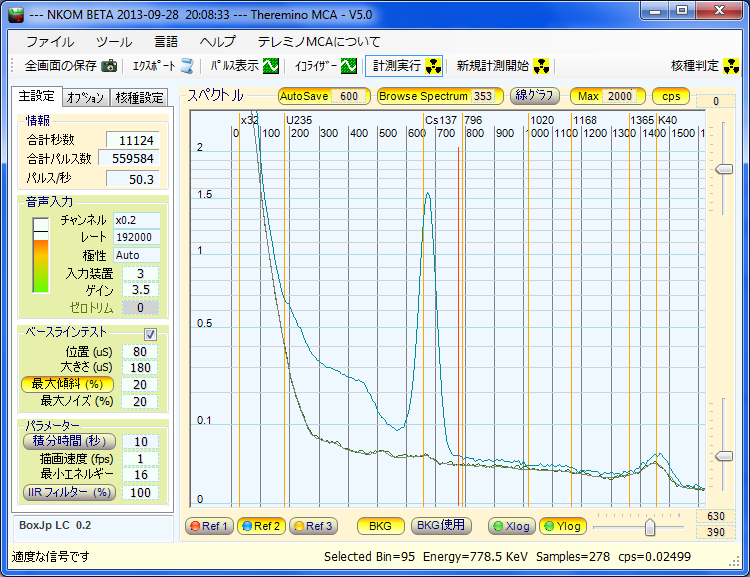
こちらのスペクトルでは、青い線が、鉛の遮蔽の中のバックグラウンドで、見やすいように拡大してあります。
緑の線は、遮蔽の外側のバックグラウンドの高さを調整し、無理やりK40などの成分を遮蔽内のバックグランドから差し引いたものです。
511KeVの消滅ピークと、662KeVのCs137のピークが遮蔽内で目立つのが分かるかと思います。
The blue line is the same background (shown in green above), emphasized a lot.
The green line is after (forcefully) subtracting a background spectrum outside lead castle to show the difference.
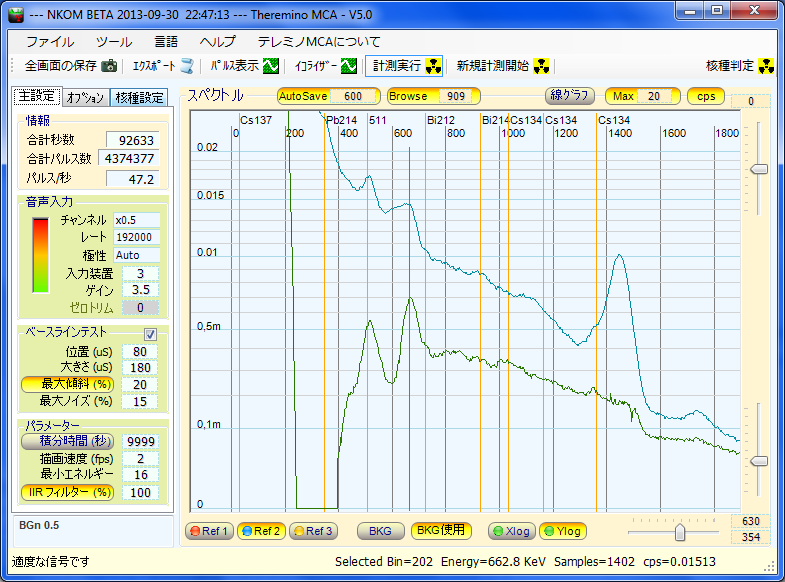
灰色の線は、遮蔽が一重で、4cm弱の厚さの時のもの、緑の線が2重の遮蔽で厚さが8cm弱の時のものです。
遮蔽を厚くすることで、K40やそのコンプトン成分、そして、609KeVのBi214などが減少しているのが分かるかと思います。
しかし、Cs137の位置では、他の部分と同じように減少しておらず、逆に目立つ結果になっています。
このことから、Cs137は、遮蔽の外部から来たものではなく、遮蔽の中にあることが予想されます。
Grey line is the background in the lead castle when it had a single layer, about an inch and 1/4 thickness.
Green line is the background in the lead castle after adding one more layer and total of about 2 1/2 inch.
We can see that the second layer decreased K40, Compton scatter, and Bi214, etc.
But Cs137 seems to be even more visible.
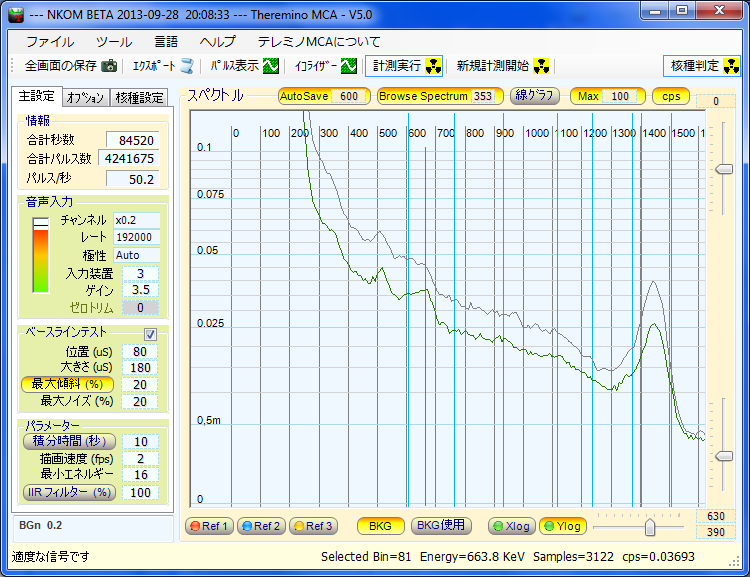
汚染源が遮蔽の中だとすると、以前の測定の際に、遮蔽内に付着して汚染した可能性や、鉛の遮蔽自体か、それを梱包している紙が汚染している可能性などが考えられます。
鉛はアリゾナから来た再生鉛で、核実験やソ連の事故、そして福島由来の鉛や紙の汚染などが頭に浮かびました。
まず、調べやすいものから調べ、幾つか有る可能性の中から汚染源の候補を絞り込む為、鉛を梱包している紙を剥がしてみましたが、ビスマスなどの低下が見られただけでCs137には変化が無かった為、紙の汚染の可能性は無くなり、遮蔽内部に汚染したホコリなどが付着していた可能性も無くなりました。
As the contamination isn't coming from outside the lead castle, the source of the contamination can be hot particles inside the lead shielding, the paper box that covers lead ingots, the lead ingots themselves, or the detector.
So, I removed the paper box, but the contamination level remained same. This also eliminated the possibility of the hot particle (sticking to the paper box).
そこで、鉛の汚染を疑ったのですが、念の為にもう一本のCsI2.5インチ測定機で測ったところ、最初のものに比べて約3倍かそれ以上の汚染があったので、測定機自体の汚染の可能性が一気に強まりました。
赤茶色の線が、CsI2.5インチの1号機。
水色の線がCsI2.5インチの2号機。
緑の線は、1号機の線をバックグラウンドに使用して、2号機の線から差し引いたもの。
感度や分解能がちょっと違うので、単純な比較は出来ませんが、それでも差は歴然としていて、測定機の特性の差だけで説明できる範囲を明らかに超えていて、測定機自体にそれぞれ違った量の自己汚染があると思われます。
Although I suspected the lead ingots as the source of contamination, I checked with another CsI2.5inch detector to be sure. And it showed about 3 times more contamination than the first detector I used.
The red line is the background of the CsI2.5" detector #1.
The blue line is the background of the CsI2.5" detector #2.
The green line is the difference between two.
Because of the huge difference, it cannot be explained solely by the divergence of detector efficiency and resolution.
Thus, it seems they are both contaminated but to different degree.
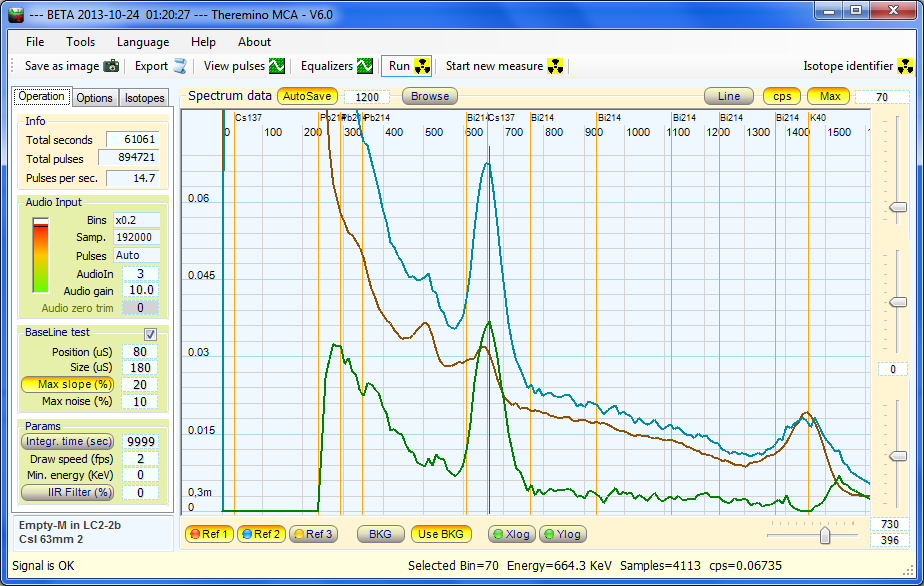
測定機に汚染が有る、と分かっても、もしかしたら鉛にも汚染があるかもしれないので、更に別のもう1本の測定機で測って見たところ、汚染は全く見られなかったので、2本の測定機の自己汚染がほぼ確実となりました。これは、662KeVで7%の分解能。
To eliminate the possibility of the contamination of lead ingots, I used yet another detector (NaI 1.5 inch).
It came out clean, and it confirmed the contamination of two detectors.
At 600 seconds. 開始600秒後。 こんなにギザギザしている状態では、まだ、どうなるか分からないので、もっと待ちます。
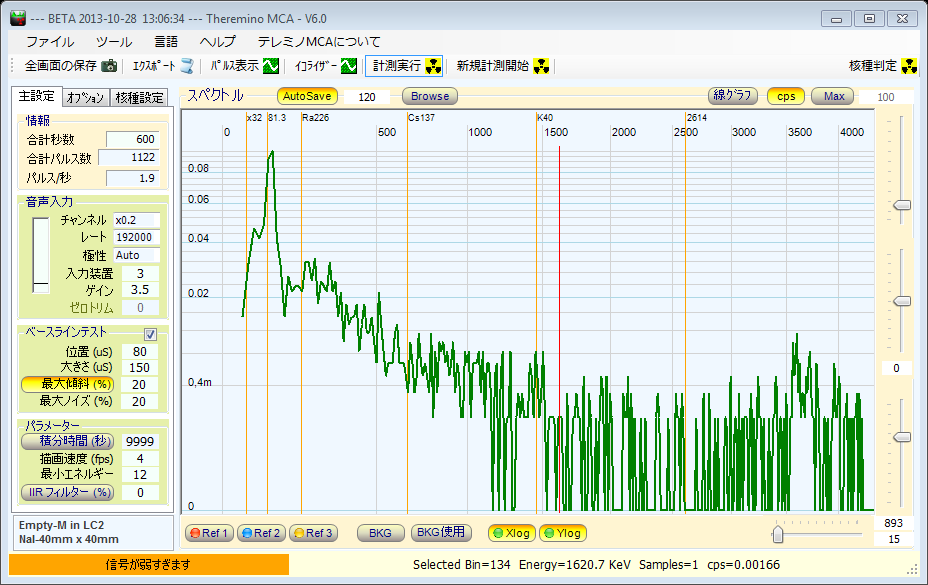
http://pico.dreamhosters.com/img/V60/2013_10_28_20_13_26-Empty-M_in_LC2-NaI-40mm_x_40mm.txt
After 7560 seconds. 7560秒後。K40や511KeVの山とか、ちょっと見えてきましたが、Cs137がツルツルになるのかは、まだ分かりません。
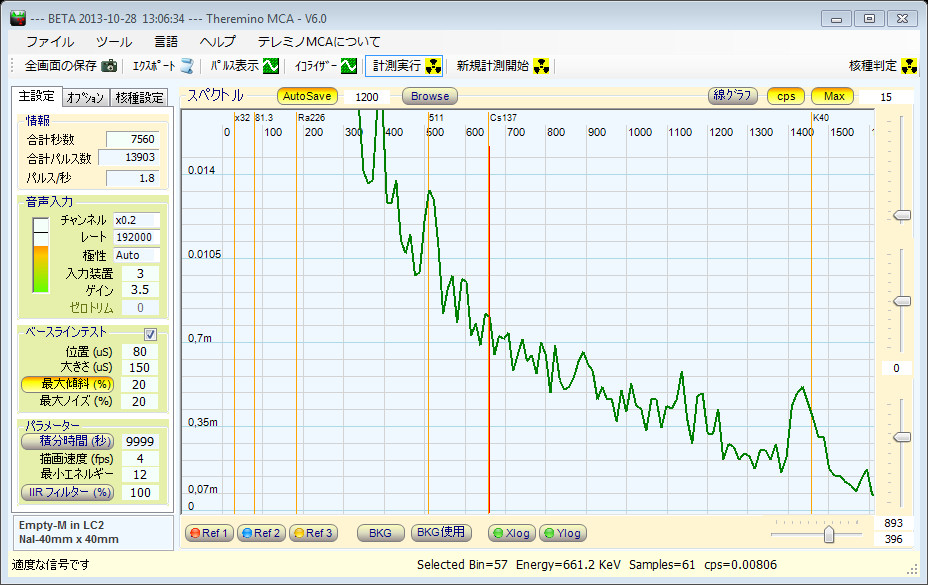
http://pico.dreamhosters.com/img/V60/2013_10_28_22_11_03-Empty-M_in_LC2-NaI-40mm_x_40mm.txt
After 85560 seconds. 85560秒後。約1日放置して、Cs137に目だった小山もないし、少しへっこんでいる部分もあるので、これ以上何も出ないでしょう、ということで打ち止め。
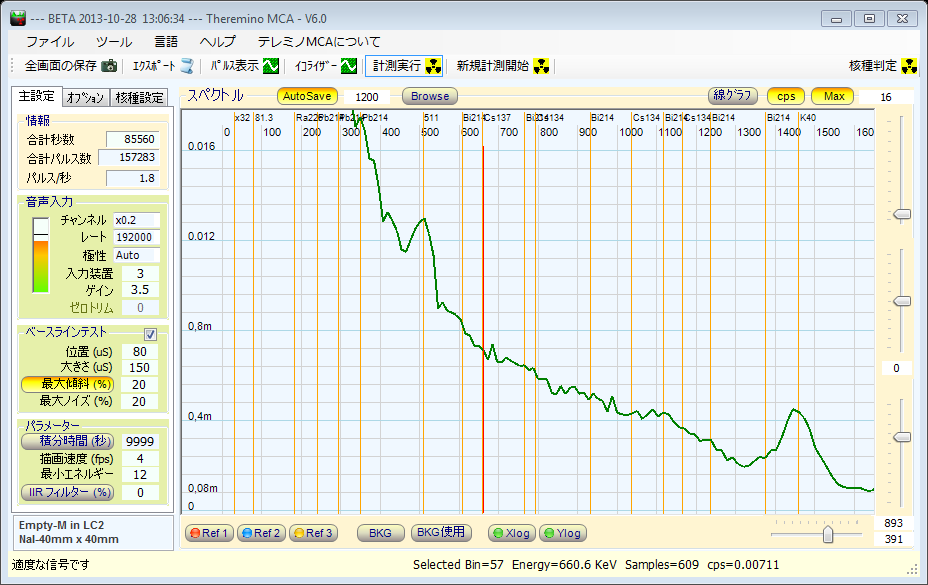
http://pico.dreamhosters.com/img/V60/2013_10_29_09_00_01-Empty-M_in_LC2-NaI-40mm_x_40mm.txt
更に、もう一本のNaI測定機でも汚染はありませんでした。これは、分解能が一番悪い測定機で、スペクトルもかなりへたっています。また、磁気遮蔽もしてないので、昨今の太陽の影響(の地磁気への影響)とか受けて、更に鈍っているかも。
I used yet another NaI 1.5" detector and there was no contamination.
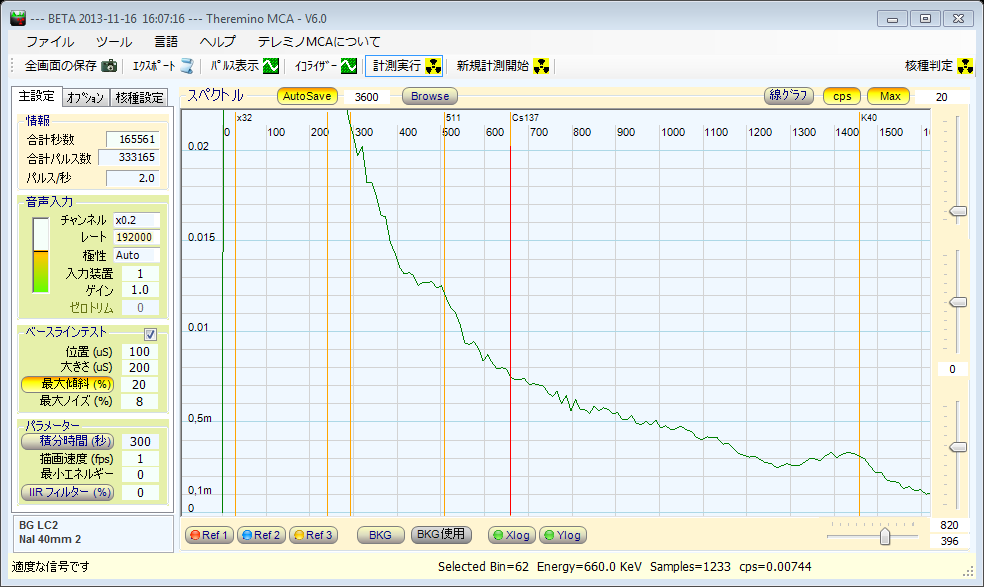
http://pico.dreamhosters.com/img/V60/2013_11_18_19_39_50-BG_LC2-NaI_40mm_2.txt
汚染が少ないほうの測定機で、地元(カナダ)のスーパーで買ったブルーベリージャムを測定して見ましたが、Cs137の山がほんの少し高くなったように見えないこともないもののはっきりとしたことは言えないスペクトルになりました。(約43時間の計測)
もし、Cs137の自己汚染がない、つるつるでスベスベのバックグラウンドがあったなら、汚染があるのかないのか、もう少しはっきりしたのかもしれません。
赤がバックグラウンド(空のマリネリ)、水色がブルーベリージャム(マリネリ入り約900グラム)、緑がバックグラウンドを差し引いたスペクトルです。
I measured blueberry Jam but the result was inconclusive (after about 43 hours)
If the background were contamination free, I might have been able to determine the presence or absence of Cs137.
Red: BKG (empty marinelli), Blue: blueberry jam in marinelli (about 900 gram), Green: after BKG subtraction.

http://pico.dreamhosters.com/img/V60/2013_11_16_09_21_37-BBJam3__LC2b-.txt
これは、汚染が酷いほうの測定機を厚さ4mmの鉛の簡易遮蔽にいれて測定したバックグラウンドです。
この程度の遮蔽だと、Bi214のせいもあって、Cs137の汚染は有るのか無いのか、よく分かりません。
水色は、分解能補償機能で強調したもの。この機能でも、Cs137は、分かりません。
This is the spectrum of the detector with three times more contamination than another one measured in a lead pipe of about 4mm thickness.
Masked by Bi214, we can't see if Cs137 is present or not.
Blue line is the spectrum emphasized with resolution compensation function. Still, Cs137 isn't clearly detectable.

遮蔽環境を強化して、予想していなかったもの(汚染)を見つけた初めてのケースが、なんと測定機の自己汚染という結論になって、多少案じていた鉛の汚染が無かったのは嬉しいのですが、やっぱり複雑な気分です。
また、少量であれ、バックグラウンドにCs137が存在すると、パッと見ただけで汚染の有無が分かる、という「パッと見限界」が高くなってしまうので困ります。
なので、汚染の酷いものについてはもちろん、汚染の低いほうも、Sovtubeでの遮蔽環境が整ったりするのをじっくりと待って取り替えて貰うか、あるいは、NaIのものにするか、などなど、まだ思案中です。
後日談:
自己汚染が少ないほうの機械で、色々測ってみたところ、Cs137が試料中に数ベクレル含まれていれば、
一応目で見てピークが分かるようで、本当に微妙な量の汚染は難しくても、二桁ベクレルくらいなら、
問題がないことが分かりました。
また、逆に、この自己汚染は、マーカーや量の比較用に使えないこともないです。
詳しくは、こちらのメープルシロップを測ったスペクトルなどをご覧ください。
Maple Syrup Spectrums